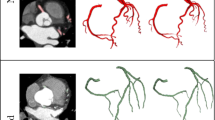Abstract
For clinical decision-making and documentation purposes we have developed techniques to extract, label and analyze the coronary vasculature from arteriograms in an automated, quantitative manner. Advanced image processing techniques were applied to extract and analyze the vasculatures from non-subtracted arteriograms while artificial intelligence techniques were employed to assign anatomical labels. Lumen diameters of 11 phantom vessels were assessed with an accuracy of 0.27±0.19 mm (d true = 0.45 + 0.92d measured ; r> 0.99) and 0.21±0.15 mm (d true =0.42+0.91d measured ; r> 0.99), from cine and digital images, respectively. We collected a total of 15 routinely acquired cine-arteriograms showing 74 vessel segments with 18 stenoses (severity larger than 30% assessed quantitatively), and 53 digital arteriograms showing 236 vessel segments with 69 stenoses. From the cine arteriograms we extracted 64 (86%) of the vessel segments without manual correction and 196 (83%) from the digital arteriograms. Repeated analysis (3 times) of the arteriograms by the same operator resulted in a standard deviation of the mean segment diameters (precision) of 0.064 mm for the cine-images and 0.020 mm for the digital images, while the standard deviations in the measurement of the minimal luminal diameter of the observed stenoses were 0.020 mm and 0.019 mm, respectively. The LAD artery, the septal and diagonal branches were correctly identified automatically in 86% of the segments. From these evaluations we conclude that our automated approach provides reliable tools for the assessment of multi-vessel disease, both in an offand on-line environment.
Similar content being viewed by others
References
Reiber JHC, Serruys PW. Quantitative coronary angiography. In: Marcus ML, Schelber HR, Skorton DJ, Wolf GL (eds). Cardiac Imaging: a companion to Braunwald's heart disease. Philadelphia: Saunders, 1991; 211–280.
Reiber JHC, Zwet PMJ van der, Koning G, Land CD von, Meurs B van, Gerbrands JJ, Buis B, Voorthuizen AE van. Accuracy and precision of quantitative digital coronary arteriography: observer-, short-, and medium-term variabilities. Cath Cardiovasc Diagnosis 1993; 28: 187–198.
Haase J, Di Mario C, Slager CJ, van der Giessen WJ, den Boer A, de Feyter P, Reiber JHC, Verdouw PD, Serruys PW. In-vivo validation of on-line and off-line geometric coronary measurements using insertion of stenosis phantoms in porcine coronary arteries. Cathet Cardiovasc Diag, 1992; 26: 16–27.
Lesperance J, Waters D. Measuring progression and regression of coronary atherosclerosis in clinical trials: problems and progress. Int J Card Imaging 1992; 8: 165–73.
Serruys PW, Simon R, Beatt KJ, eds. PTCA. An environmental tool an a non-operative treatment of acute ischemia. Dordrecht: Kluwer Academic Publishers, 1991.
Sigwart U, Puel J, Mirkovitch V, Joffre F, Kappenberger L. Intravascular stents to prevent occlusion and restenosis after transluminal angioplasty. N Eng J Med 1987; 316: 701–706.
Dumay ACM. Image reconstruction from biplane angiographic projections. PhD thesis, Delft University of Technology, 1992.
Beier J, Oswald H, Sauer U, Fleck E. Edge detection for coronary angiograms: error correction and impact of derivatives. Proc Int Symp CAR'91, 1991; 721–726.
Gerbrands JJ. Segmentation of noisy images. PhD thesis, Delft University of Technology, 1988.
Dodge JT Jr, Brown BG, Bolsen EL, Dodge HT. Intrathoracic spatial location of specified coronary segments on the normal human heart. Applications in quantitative arteriography, assessment of regional risk and contraction and anatomic display. Circulation 1988; 78: 1167–1180.
Dodge JT Jr, Brown BG, Bolsen EL, Dodge HT. Lumen diameter of normal human coronary arteries. Influence of age, gender, anatomic variation and left ventricular hypertrophy or dilation. Submitted.
Dumay ACM, van der Geest RJ, Gerbrands JJ, Reiber JHC. Consistent inexact graph matching applied to labelling coronary segments in angiograms. Proc of the 11th IAPR Int. Conf. on Pattern Recognition 1992; 439–442.
Rich E. Artificial intelligence. New York: McGraw-Hill, Inc. 1983.
van der Zwet PJM, von Land CD, Loois G, Gerbrands JJ, Reiber JHC. An on-line system for the quantitative analysis of coronary arterial segments. Proc Comput Cardiol, IEEE Comput Soc, 1990; 157–160.
Austin WG, Edwards JE, Frye RL, Gensini GG, Gott VL, Griffith LSC, McGoon DC, Murphy ML, Roe BB. A reporting system on patients evaluated for coronary artery disease, report of theAd Hoc Committee for Grading of Coronary Artery Disease, Council on Cardiovascular Surgery, American Heart Association. Circulation 1975; 51: 7–40.
Beier J, Oswald H, Fleck E. Edge detection for coronary angiograms: error correction and impact of derivatives. Proc Comput Cardiol, IEEE Comput Soc 1992; 513–516.
Dumay ACM, Reiber JHC. Determination of optimal angiographic viewing angles: Basic principles and evaluation study. IEEE Trans. on Med. Imaging. March 1994. Accepted.
Author information
Authors and Affiliations
Rights and permissions
About this article
Cite this article
Dumay, A.C.M., Gerbrands, J.J. & Reiber, J.H.C. Automated extraction, labelling and analysis of the coronary vasculature from arteriograms. Int J Cardiac Imag 10, 205–215 (1994). https://doi.org/10.1007/BF01137902
Accepted:
Issue Date:
DOI: https://doi.org/10.1007/BF01137902




